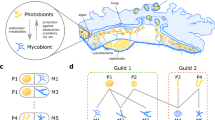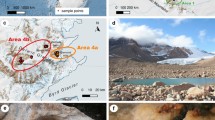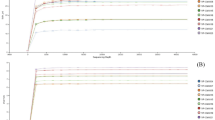Abstract
THE ascocarps of lichens vary in form from one species to another. Their development in several species has been examined by Doppelbaur1, but nothing is known of the mechanism controlling their morphology. Study of a recently identified lichen parasymbiont suggests that the thallus may have a determining role.
This is a preview of subscription content, access via your institution
Access options
Subscribe to this journal
Receive 51 print issues and online access
$199.00 per year
only $3.90 per issue
Buy this article
- Purchase on SpringerLink
- Instant access to full article PDF
Prices may be subject to local taxes which are calculated during checkout
Similar content being viewed by others
References
Doppelbaur, H. W., Planta, 53, 246 (1959).
Deakin, R., Ann. Mag. Nat. Hist., Ser. 2, 13, 32 (1845).
Bouly de Lesdain, M., Recherches sur les Lichens des Environs de Dunkerque, 257 (Dunkerque, 1910).
Erichsen, C. F. E., Flechtenflora von Nordwestdeutschland, 45 (Stuttgart, 1957).
Keissler, K. von, in Zahlbruckner, A., Dr. L. Rabenhorst's Kryptogamen-Flora von Deutschland, etc., 9, Abt. 1, Teil 2, 224 (Leipzig, 1938).
Keissler, K. von, in Zahlbruckner, A., Dr. L. Rabenhorst's Kryptogamen-Flora von Deutschland, etc., 9, Abt. 1, Teil 2, 452 (Leipzig, 1938).
Bommer, C., Bull. Soc. Belge Microscop., 17, 151 (1891).
Swinscow, T. D. V., Lichenologist, 1, 169 (1960).
Author information
Authors and Affiliations
Rights and permissions
About this article
Cite this article
SWINSCOW, T. An Unusual Parasymbiont of Marine Lichens. Nature 194, 500–501 (1962). https://doi.org/10.1038/194500b0
Issue date:
DOI: https://doi.org/10.1038/194500b0



